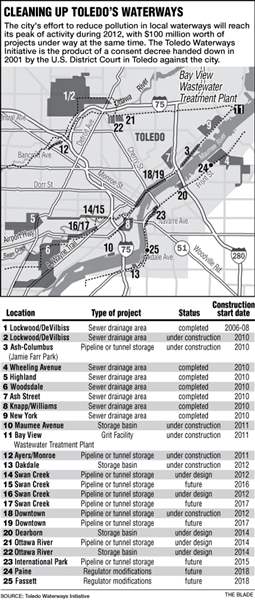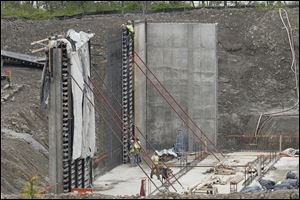
Sewer work starts as part of $521M plan
11 major projects lead 20-year effort
5/1/2012

Construction crews work to build an underground sewage storage tank at Nicholson Park along the Maumee Rvier on Monday, one of several projects that is part of the Toledo Waterways Initiative.
Ten years ago this summer, Toledo voters overwhelmingly approved the city's settlement of a long-running U.S. Environmental Protection Agency lawsuit regarding sewage overflows, even though it was forecast to require $400 million in construction and cause city sewer rates to double.
Today, that estimate is up to $521 million, and every sewer customer in Toledo is charged $15.82 per quarter -- about $65 per year -- to pay for the work, except for those with homestead exemptions, who pay $11.87 per quarter.
Sewer bills actually have more than doubled over those 10 years: For a typical quarterly user of 3,000 gallons of water, the bill is now $142.34, which includes $126.52 plus the Toledo Waterways Initiative surcharge.
And all over Toledo's older neighborhoods -- where sanitary sewers and storm drains were built as a combined system during eras when allowing overflows to dump directly into nearby rivers was a common practice -- the projects to correct Toledo's sewage-related pollution this year are reaching the campaign's peak.
Eleven major projects -- five that start this year, three that will be finished this year, and three others that are somewhere in between during 2012 -- will keep a city, consultant, and contractor work force estimated at more than 200 people working, to the tune of more than $100 million, city leaders said during a news conference Monday afternoon.
At no time during the previous 10 years have so many different projects been under way, nor is it expected to be so busy as it is this year during the campaign's remaining years before its scheduled 2020 completion, said George Robinson II, deputy director of the Toledo Department of Public Utilities, who is in charge of the program.

"Not only are we improving our [sewage-treatment] system, we are creating very positive jobs at a time when they are needed," Mayor Mike Bell said. The benefits, he said, will accrue to "the future people who are going to live here."
Construction is under way on huge underground sewage storage tanks beneath parts of several city parks, including Ottawa Park in West Toledo, Nicholson Park at the foot of Maumee Avenue along the Maumee River, and Beatty Park in the central city.
Work to clean debris from three large sewer tunnels built 20 years ago, including one underneath Superior Street downtown, begins this year. Community meetings about the Superior tunnel clean-out are scheduled for May 15 at 6 p.m., and May 16 at 2 p.m., at the Toledo Regional Chamber of Commerce.
Construction of a sewer main along Parkside Boulevard, which will feed into the new basin at Ottawa Park, began in March. And construction of an 8-million-gallon storage basin beneath what is now an industrial pond belonging to Pilkington North America in East Toledo, along Miami Street near Oakdale Avenue, is scheduled to start today.
Projects to be completed in 2012 include the Lockwood-DeVilbiss sewer separation, the final phase of which involves construction along various streets in the Library Village area of West Toledo; the Ash/Columbus storage pipeline, a nine-foot retention tunnel under construction between Jamie Farr Park and the Maumee River; and the Detroit Sanitary Sewer Overflow storage basin, another 8-million-gallon underground tank being installed near Schneider Park in South Toledo.
"It's a huge project -- one of the biggest the city has ever undertaken," said Joe McNamara, president of city council and chairman of its utilities committee. "But it's something that we have to do. A lot of people are frustrated with the higher bills, but it's because we're doing all these projects. One of the problems with building Toledo over a swamp is you have a lot of excess water you have to deal with."
The biggest public-works project in Toledo's history, Toledo Waterways Initiative is the product of a consent decree handed down in 2001 by the U.S. District Court in Toledo against the city to conclude an 11-year U.S. Environmental Protection Agency lawsuit.
About one-third of the city's sewer system -- mostly in the oldest parts of town, but including some post-World War II neighborhoods -- was built with combined sewers. When too much water flowed into those pipes, it overflowed at several dozen locations, either directly into the Ottawa River, Swan Creek, or Maumee River, or into tributaries to those waterways. Even then, the city's sewage-treatment plant often couldn't handle the remaining flow, and it discharged partially treated sewage directly into the Maumee.
Treatment plant modernization was one of the initiative's early tasks, and one aspect of that -- replacing the 1930s-vintage grit-removal system at the Bay View plant -- continues.
When finished in 2014, the system to remove sand, gravel, and other heavy solids from city sewage will have a daily capacity of 195 million gallons per day, up from 168 million gallons.
The city charter required a referendum on the consent decree because of the huge expected construction cost. Even then, $400 million was a rough estimate, and David Welch, the city's public utilities director, said Monday the true number has been higher in part because sewer overflow points were built into the system that weren't documented.
Mr. Robinson said that so far, the program has hit "all of our milestone dates" for both construction and documentation.
Initially scheduled for completion in 15 years, the city negotiated a four-year extension that officials said saved Toledo ratepayers about $36 million.
Most of the payments will come from customers: only between 5 and 10 percent is covered by grants, with the balance financed with federal loans at 2.2 to 3.2 percent interest that won't be fully paid off until 2040.
So far, Mr. Welch said, the city has spent about $250 million on the sewer-modernization campaign.
And Mr. Robinson said benefits already are starting to appear: parts of the Ottawa River, which at bridges has had signs posted for years declaring a health hazard, recently have been declared safe for boating.
The Toledo Waterways Initiative will create "a better environment for the waterways" that have been polluted for generations by overflows and treatment-plant bypasses, he said.
Contact David Patch at: dpatch@theblade.com or 419-724-6094.